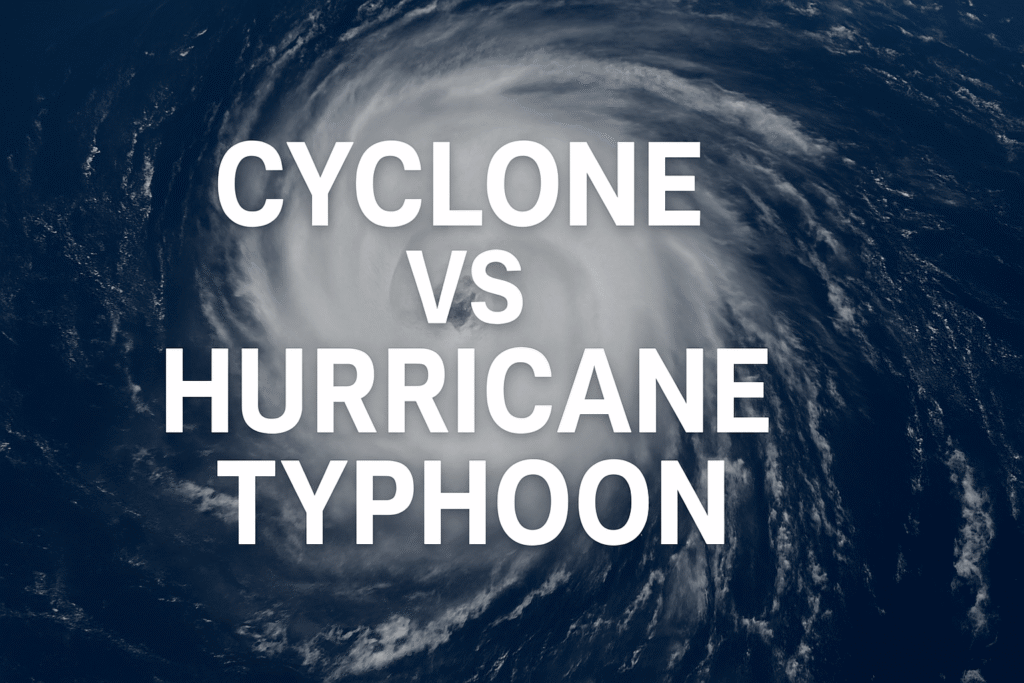Have you ever wondered why the same weather phenomenon has three different names—cyclone, hurricane, and typhoon? It might seem confusing, but the explanation is simpler than you think. These three terms actually describe the same powerful weather event: a tropical cyclone. Let’s dive deeper into this intriguing meteorological puzzle.
One Storm, Three Different Names
Though commonly mistaken for distinct types of storms, cyclones, hurricanes, and typhoons are essentially the same phenomenon scientifically known as tropical cyclones. The terminology differs based solely on the geographical location where the storm develops:
- Hurricanes occur in the North Atlantic Ocean, the Caribbean Sea, and the Northeastern and Central Pacific Oceans.
- Typhoons form in the Northwest Pacific Ocean, typically affecting countries in East Asia and Southeast Asia.
- Cyclones are common in the Indian Ocean and South Pacific regions, notably affecting countries like Australia, India, and Madagascar.
These storms earn their respective names once their sustained winds reach at least 119 km/h (74 mph), marking their transition from a tropical storm to a full-fledged cyclone, hurricane, or typhoon.
The Ingredients for a Tropical Cyclone
For a tropical cyclone to form and intensify, several specific conditions must align perfectly:
- Warm Sea Surface Temperatures: The water temperature must be at least 26.5°C (80°F), extending roughly 50 meters deep, providing the heat energy that fuels the storm.
- High Humidity: Moisture-rich air at mid-tropospheric levels enhances the cloud formation necessary for sustaining the storm.
- Low Vertical Wind Shear: Minimal wind shear (the difference in wind speed and direction at different altitudes) allows a cyclone’s structure to remain intact and strengthen.
- Coriolis Effect: This effect, due to Earth’s rotation, is essential for initiating and maintaining the cyclone’s characteristic rotation, meaning storms rarely form near the equator.
- Pre-existing Disturbance: A cluster of thunderstorms or low-pressure disturbances must exist to provide a focal point for cyclone formation.
When these conditions persist, latent heat from condensation processes fuels the storm, intensifying it into a powerful tropical cyclone.
How Many Tropical Cyclones Form Annually?
Globally, approximately 85 tropical cyclones develop each year, though numbers can vary significantly. Of these, about half strengthen into hurricanes or typhoons:
- The Atlantic hurricane season typically peaks from late August to September.
- The Pacific typhoon season usually reaches its peak intensity around early September.
- The Indian Ocean has two cyclone seasons each year, peaking in May and November.
Though many storms form annually, only a subset makes landfall, often causing widespread damage and necessitating preparedness and early warning systems.
Measuring Storm Strength: Different Regions, Different Scales
Various scales exist to measure tropical cyclone intensity, each tailored to the specific geographic region:
- Saffir-Simpson Hurricane Wind Scale (North Atlantic and Eastern/Central Pacific): Categories range from 1 (minimal damage, winds starting at 74 mph) to Category 5 (catastrophic damage, winds exceeding 157 mph).
- Australian Tropical Cyclone Intensity Scale (South Pacific and Indian Ocean regions): Categories 1 to 5, similar in concept to the Saffir-Simpson scale but based on different wind speed averages.
These classification systems help forecasters communicate potential impacts clearly and effectively to the public.
The Historical Origin of Storm Names
Historically, different cultures and maritime traditions influenced how storms were named, leading to the diversity we see today. Initially, storms were often named after saints, locations, or significant events. During the 20th century, naming conventions became standardized to avoid confusion, simplify communication, and facilitate public warnings.
Today, the World Meteorological Organization (WMO) maintains rotating lists of storm names contributed by member countries. When a storm causes severe damage or loss of life, its name is retired permanently to honor the memory of victims and replaced with a new name in future lists.
Climate Change and Tropical Cyclones
Climate change is altering the characteristics and impacts of tropical cyclones in notable ways:
- Increasing Intensity: Rising sea surface temperatures lead to stronger storms, with a higher proportion reaching Category 3–5 intensity.
- Enhanced Rainfall: A warmer atmosphere holds more moisture, resulting in significantly heavier rainfall and increased flood risks associated with tropical cyclones.
- Uncertain Frequency Trends: While the intensity of storms appears to be increasing, scientists remain uncertain whether the total number of tropical cyclones will significantly rise or stay relatively stable.
Climate-related changes present significant challenges, prompting increased research and enhanced preparedness strategies worldwide.
Advancements in Forecasting and Preparedness
Forecasting tropical cyclones has improved dramatically in recent years, thanks to advancements in technology, modeling, and global cooperation:
- Enhanced Satellite Technology: Advanced satellite systems provide frequent updates, improving predictions of storm paths and intensities.
- Improved Forecast Models: NOAA’s Hurricane Analysis and Forecast System (HAFS), for instance, significantly reduced forecast errors and enhanced prediction accuracy.
- Impact-Based Warnings: Modern warning systems now consider multiple hazards—wind, storm surge, flooding—to communicate comprehensive risks clearly and effectively to vulnerable populations.
Lessons Learned and Future Challenges
Historical cyclones, hurricanes, and typhoons provide crucial lessons in emergency response, infrastructure resilience, and community preparedness:
- Storm Surge Preparedness: Communities have learned the importance of evacuation routes and coastal infrastructure capable of withstanding severe storm surges.
- Infrastructure Resilience: Building codes have evolved to mitigate wind damage and protect vital infrastructure from catastrophic impacts.
- Community Engagement: Effective communication and public awareness campaigns have significantly improved preparedness and reduced mortality rates during severe storms.
Global Perspectives and Regional Differences
Regional experiences vary significantly due to geographic, economic, and societal factors. Developing regions often face higher vulnerabilities, requiring substantial international cooperation and aid. In contrast, developed regions invest heavily in resilient infrastructure and advanced early-warning systems.
A Unified Understanding
Ultimately, whether we call these powerful storms cyclones, hurricanes, or typhoons, their destructive potential remains universally acknowledged. Understanding their formation, classification, naming conventions, climate impacts, and forecasting advancements is crucial for preparedness and disaster risk reduction. Enhanced global cooperation, ongoing research, and public education are essential in minimizing impacts and safeguarding lives.
Stay vigilant, stay informed, and prioritize safety above all.

